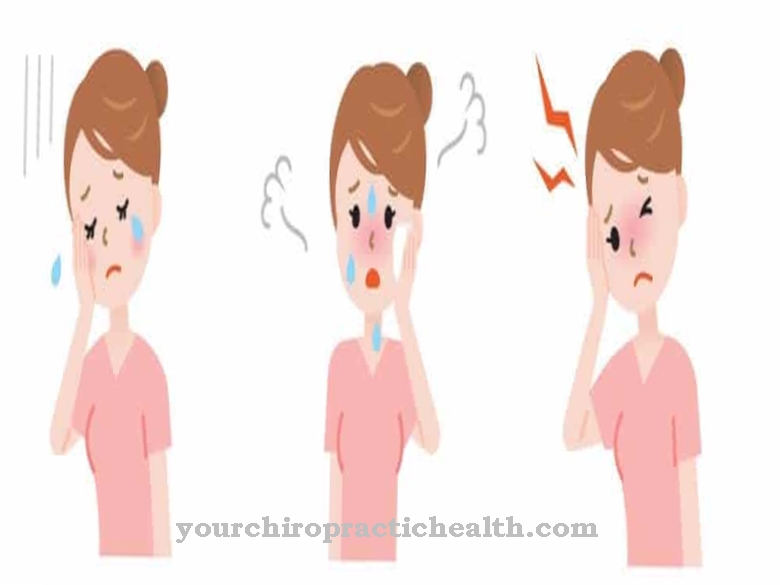Dysmorphophobia is the exaggerated intellectual preoccupation with a self-suspected physical distortion. So it is a wrong body perception. Also known as disfigurement syndrome, this psychiatric disorder is characterized by an obsessive and excessive urge to perceive yourself as obnoxious or ugly. For a long time scientifically controversial, body dysmorphic disorder is once again the focus of medical discussion.
What is dysmorphophobia?

© vf1 - stock.adobe.com
The word dysmorphophobia consists of three compound Greek syllables - "dys", "morph" and "phobios". It describes the shyness, fear or fear of one's own external appearance, of one's own external shape. Today, the so-called body dysmorphic disorder is classified and recognized as an independent, psychiatric disease picture. So if a patient is diagnosed with dysmorphophobia, they have the right to adequate therapy.
The mental illness often has a very negative impact on the lives of those affected due to the false perception of their own self-image and often leads to depression, and cases of suicide due to dysmorphophobia have also been proven.
Due to the possibilities of cosmetic plastic surgery, which has made enormous progress in recent years, this psychiatric disorder is moving more into focus again. If one's own self-perception is permanently disturbed, however, it is questionable whether the patient can really be helped permanently with such an intervention.
causes
In the case of dysmorphophobia, an unprocessed, inner-soul conflict is assumed. Efficiency and quality of life decrease more and more, as the mind loops of those affected revolve only around the supposed distortion of the face or other body parts.
Even if the affected person is credibly assured by relatives or doctors that there is a distorted picture of their own perception and reality, this is negated by the patient. In addition, it is often the case that the sick fearfully avoid the advice of experts, for example specialized psychiatrists.
Body dysmorphic disorders are often associated with a lack of self-esteem and hypochondria. Since many sufferers avoid contact with a doctor in connection with their misguided body awareness, a high number of unreported cases must be assumed. Everyone has certain physical features that characterize them and make them unique. Most people get along well with it, but the concerns of patients with dysmorphophobia are always characterized by a clear exaggeration.
You can find your medication here
➔ Medicines to calm down and strengthen nervesSymptoms, ailments & signs
There are no reliable data in the medical literature on the gender distribution of the disfigurement syndrome, as exact studies have not yet been carried out. Specialist authors assume an equal distribution between men and women, others describe a slight predominance of the female sex.
What is certain, however, is that dysmorphic behaviors can already begin in childhood and adolescence. Once the excessive preoccupation with one's own physical appearance is set in motion, the symptoms and complaints worsen with increasing age.
However, the longer the symptoms persist, the more difficult it is to initiate adequate psychiatric therapy. The sick experience themselves as supposedly ridiculous, repulsive or ugly, although objectively they look completely normal. The idea of one's own ugliness often relates to the whole body, less often to individual areas.
In particular, the shape, symmetry, size or position of certain body areas or extremities are questioned. Typical examples are the distribution of fat, dissatisfaction with the position of the teeth, a tendency to redden or the wrong assumption that the lips, chin, cheeks, mouth or nose are ugly.
Diagnosis & course
Those affected suffer from a self-created vicious cycle of self-rejection and agonizing concern. It is typical that one's own appearance is constantly questioned or checked in mirrors. The deep psychiatric diagnosis often reveals narcissistic personality traits and profound inferiority. Due to the general tendency to withdraw and shyness, the psychosocial consequences for those affected are often considerable.
In many cases, it is the general practitioner who, with his good knowledge of the patient, makes a suspected diagnosis, which must then be confirmed by a psychiatrist or psychological psychotherapist. An adequate therapy should therefore also be initiated early enough so that a tendency towards chronification can be effectively counteracted. Because the course of the disease is considered protracted, and it is not uncommon for those affected to remain prisoners of their fears of pathological disfigurement for a lifetime.
When should you go to the doctor?
As a rule, those affected suffer from a number of different psychological complaints due to dysmorphophobia. For this reason, a doctor should be consulted with this disease if there are significant inferiority complexes or a reduced self-esteem. Urgent treatment is especially necessary if these symptoms occur for no specific reason. Medical treatment is also useful if teasing or bullying occurs in order to avoid further complications and complaints.
Furthermore, the dysmorphophobia can also lead to thoughts of suicide. In many cases, the patient's parents and relatives must also be aware of the symptoms and contact a doctor. In severe cases, it makes sense to stay in a closed clinic. This can significantly alleviate the symptoms. Most often, the diagnosis of dysmorphophobia is made by a psychologist. Treatment can also be carried out by a psychologist. The earlier the disease is diagnosed and treated, the higher the chances of a complete cure for the patient.
Doctors & therapists in your area
Treatment & Therapy
A schematic psychiatric treatment for wrong body perception is still not known, which is why every therapy for a dysmorphic disorder must be based on the individual situation and problem of a patient. The therapist must first manage that a patient opens up to him, gains trust and wants to be helped at all. A causal, i.e. cause-related therapy, is not possible because the psychological background of the dysmorphophobia is still unknown.
Only when depression occurs at the same time is the administration of psychotropic drugs justified. The therapy is otherwise limited to accompanying psychotherapeutic sessions of behavioral therapy. If patients express varying, vague or diffuse complaints, cosmetic operations are strongly discouraged. Because the mental impairments hidden behind the complaints cannot be removed by a desired medical cosmetic surgery.
Outlook & forecast
In dysmorphophobia there is a prospect of a cure as soon as the disease is professionally treated therapeutically and the diagnosis and therapy take place at an early stage.
Most patients experience an improvement in their health with cognitive behavioral therapy. The therapy can be carried out as an inpatient or outpatient. When used in conjunction with drug treatment, significant relief of symptoms is seen in patients.
The administration of medicines without psychotherapy have proven less effective. In most cases, symptoms will resolve as soon as the prescribed drugs are stopped. The best prospects for recovery are the combination of therapy and medication. Therapy lasts for several months or years. The complaints gradually recede until they are free of symptoms.
If left untreated, the dysmorphophobia can develop into a chronic course. The prognosis deteriorates significantly. Spontaneous healing is considered very unlikely. The symptoms of the disease fluctuate in intensity as the disease progresses. At the same time, however, the symptoms get worse the longer the disease is present. As the symptoms increase, the patient's risk of suicide gradually increases. Timely therapy is crucial so that no critical or life-threatening situation occurs.
You can find your medication here
➔ Medicines to calm down and strengthen nervesprevention
Dysmorphophobia is a highly complex, sometimes bizarre, picture of suffering with a persistently negative body perception. Since it must often be assumed that the cause of the symptoms is laid in childhood, prevention should start here.
In the case of children and adolescents with a tendency to withdraw or who are constantly preoccupied with their own deficiencies, socio-therapeutic corrections should be made at an early stage or conversational psychological offers should be made.
Aftercare
Since dysmorphophobia is a serious and, above all, serious psychological disorder of the person concerned, the person concerned is usually first dependent on intensive psychological treatment by a doctor. In most cases, self-healing cannot occur, so treatment should always be carried out. Measures or options for follow-up care are usually not available to those affected with dysmorphophobia.
The triggers for this disease should definitely be recognized and avoided. The earlier the disease is recognized and treated, the better the further course is usually. The dysmorphophobia is treated with the help of medication and psychological counseling. It is important to ensure that the dosage is correct and that the medication is taken regularly so that there are no further complications.
The relatives and family of the person affected must understand the disease and deal with it. In doing so, intensive discussions with the person affected are often necessary. In serious cases, relatives should persuade the patient to seek treatment in a closed institution so that no further complaints arise. The dysmorphophobia does not reduce the life expectancy of the person affected.
You can do that yourself
In the case of dysmorphophobia, the possibilities for self-help in everyday life are only very limited for the sick person. Normally, the person concerned is not at all able to carry out the health-promoting measures on his own initiative. The disorder is based on psychological causes and the impossibility of a real self-assessment. Therefore, there are only few action variations for the person concerned.
Your own body is not deliberately misperceived. The disturbance cannot therefore be controlled deliberately. It is part of the appearance of the disease that the person affected is not able to see their own body for real and to recognize the contours. For this reason, people from the close social environment are often more responsible. They should ask the sick person about the help they need. A stable relationship of trust is necessary for this. In severe cases, relatives also need advice and help from expert staff.
Information about the disease and its appearance are necessary in order to learn and implement the correct approach to dealing with the sick person. Patience, calm and comprehensive information about the disease are essential for this. The person concerned must not be harassed or put under pressure through everyday comments. Shame, feelings of guilt, or doctrinal words should be avoided whenever possible.


.jpg)










.jpg)

.jpg)
.jpg)











.jpg)